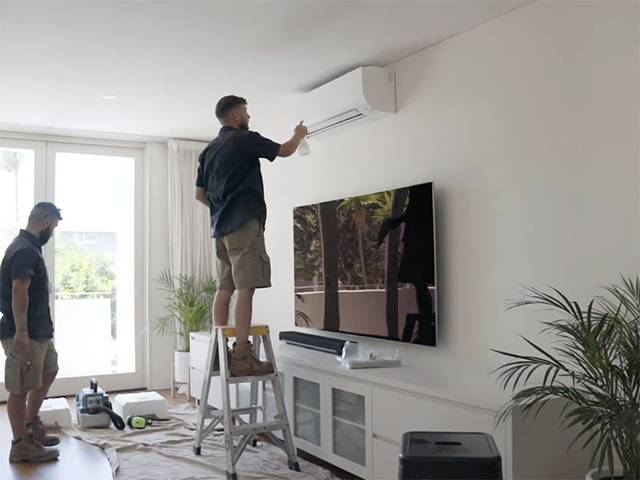How To Ensure Perfect Indoor Temperature Year-Round

Are you tired of feeling like Goldilocks in your own home, constantly adjusting the thermostat to get the temperature just right? Well, you're not alone. Finding the perfect indoor temperature in Australia can be a challenge, especially with fluctuating weather patterns.
But don't sweat it " we'll help you find the right solutions to maintain the ideal temperature in your home without breaking the bank. So let's get started!
What is the ideal temperature for indoor living in Australia?
According to the WHO, in countries with temperate or colder climates, 18 °C has been proposed as a safe and well-balanced indoor temperature to protect the health of general populations during cold seasons.
For summers, the ideal temperature should range between 25 and 27°C. It is important to note that the ideal temperature can vary depending on the season, location, and personal preferences.
How do I keep my house temperature perfect year-round?
There are three simple solutions to keep indoor temperature perfect year-round.
1. Invest in proper insulation
Improper insulation is an unexpected cause of a high energy bill as well as an uncomfortable temperature. Studies estimate that 40% of Aussies believe their home feels colder inside than outside during coldest weeks.So make sure to check that your walls, windows, doors, and roof are insulated to prevent heat loss during winter and heat gain during summer.
2. Utilise air conditioning in summer
Proper use of air conditioning can help regulate your home's temperature. Also make sure to use ceiling fans to circulate air during summer and close blinds and curtains to keep the sun out during the day. Finally, you might need to upgrade your air conditioner if it's declining in performance. Check out this guide to know when you should upgrade your air conditioner.
Moreover, professionally installed AC systems also mitigate the risks of poor indoor air quality by removing harmful allergens and particles from the air. This can be particularly helpful for those who suffer from asthma and allergies during the springtime.
3. Consider ducted gas heating for winters
Ducted gas heating is a popular choice for keeping homes warm and cosy during winters in Australia. It uses natural gas to warm air, which is then distributed through a network of ducts installed throughout a property.
The warm air is delivered through vents located in each room or area, providing central heating. However, make sure to set your thermostat to a comfortable temperature range of 18°C to 21°C during the day and lower it by a few degrees at night. You can check out qualified installers Alliance Climate Control if you're looking for professional ducted heating installation.
Also keep your home well-insulated to prevent heat loss. And just like during the summers, use ceiling fans to circulate warm air throughout your home. They are energy-efficient and effective in keeping your home warm and cosy.
What are some tips for choosing the right thermostat for my home?
In addition to the ideas mentioned above, choosing the right thermostat is essential for ensuring the perfect temperature. Here are four tips to help you choose the right thermostat:
- Think about your lifestyle and needs. For example, you might want a thermostat that you can program to adjust the temperature based on your schedule.
- Look for a thermostat that has energy-saving features such as a programmable schedule or motion sensors that can detect when you're not at home and adjust the temperature accordingly.
- Check the compatibility of the thermostat with your heating and cooling system. Some thermostats are compatible with only certain systems, so make sure to check before making a purchase.
- Consider the design of the thermostat and choose one that complements your home's decor.
How can I efficiently use air conditioning to regulate indoor temperature?
To regulate your indoor temperature using an air conditioner, the first step is to set it to a temperature range of 22°C to 24°C.
In addition, use a programmable thermostat, ceiling fans, and shades or curtains to block out sunlight. You also want to keep your air conditioner well-maintained by cleaning or replacing the air filters regularly.
If you're inexperienced with air conditioners, it's best to have the system serviced by a qualified technician once a year.
What are some ways to draught-proof my home to maintain its indoor temperature?
Draught-proofing your home can help prevent cold air from entering it during winter and hot air from entering it during summer. Below are four tips to get you started:
1) Seal gaps and cracks
Seal gaps and cracks around doors, windows, and walls using weatherstripping or caulking. This can prevent cold air from entering your home and warm air from escaping.
2) Insulate your home
Insulate your home to prevent heat loss in winter and heat gain in summer. You can insulate your roof, walls, and floors using materials such as fibreglass or cellulose.
3) Use heavy curtains
Heavy curtains can help insulate your home by trapping warm air inside during winter and blocking out sunlight during summer.
4) Use door snakes
They can be placed at the bottom of doors to prevent cold air from entering your home.
How can proper ventilation help regulate indoor temperature?
We don't usually think about ventilation when it comes to regulating indoor temperature. But proper ventilation can:
- Remove excess moisture
- Control indoor temperature
- Improve air quality
- Save energy
So make sure to open windows and doors during cooler parts of the day and night to allow fresh outdoor air to circulate in your home. Also use fans to increase air movement and create a breeze, as explained earlier.
Finally, it might also be a good idea to choose natural ventilation strategies, such as cross-ventilation. It involves opening windows on opposite sides of your home to create a flow of fresh air.
MORE



